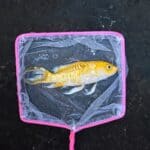Angelfish need hiding spots to avoid predators and aggressive tank mates.
They’ll also hide if the water conditions aren’t right, like when the water’s too hard, too warm or cold, or the pH levels are unbalanced.
If the tank’s overcrowded, angelfish must hide because they don’t like competing with other fish. Also, shy angelfish prefer to keep themselves hidden away.
If fish are unwell, they need time to recover from and do so by isolating themselves.
Why Do Angelfish Hide?
When it comes to why angelfish hides, there’s no one answer. All fish are different, and each has a unique experience within the aquarium.
For example, some fish are dominant and enjoy the pick of the entire tank, while others spend their life running away from bullies.
Regardless, angelfish need hiding spots to feel safe and secure. Without them, they’re vulnerable to attack and are at risk of stress.
While there are several reasons why angelfish need hiding spots, these are the most common:
Natural Behavior
In the wild Amazon River, where most angelfish hail from, there’s abundant plant life for them to hide amongst. As a result, hiding is a natural behavior for cichlids.
Similarly, some angelfish are shy. If you’ve recently got your angelfish or added new ones into the aquarium to boost your fish’s numbers, they’re likely hiding while they get used to their surroundings.
This isn’t anything to worry about because the fish will emerge in their own time.

Predators
Your angelfish need to be able to hide if they feel wary of predators. While angelfish are ambush predators that eat worms and small invertebrates, they’re also prey fish in the wild for larger marine life.
These instincts are ingrained, so if larger fish are in the tank, angelfish won’t feel comfortable enough to swim freely. Instead, they’ll take shelter amongst plants and rocks where they won’t be eaten.
You must perform research before putting other fish species in with your angelfish. Only choose compatible varieties. It’s another reason there should be hiding spots within the tank.
Aggressive Companions
Angelfish hide behind plants and decorative features to seek refuge from territorial tank mates.
If they don’t have enough hiding spots, they’re vulnerable to attack. Most angelfish are peaceful fish, especially compared to their cichlid brothers and sisters, so they prefer not to fight if they can avoid it.
Without enough hiding spaces, angelfish are at risk of stress. Symptoms include:
- Red eyes.
- White spots on the body.
- General unwellness.
- Gasping at the surface of the tank.
- Lack of appetite.
- Refusal to eat.
- Frantic swimming.
- Odd swimming patterns.
If you notice the same angelfish hiding away repeatedly, you might have to separate it from the other fish in the tank to allow it some peace. Otherwise, it’ll die from the stress.
Unfortunately, not all fish are compatible. These fish shouldn’t be paired with your angelfish, as their personalities will clash:
- Betta.
- Jack Dempseys.
- Green terrors.
- Peacock bass.
- Silver Arowanas.
- Tiger barbs.
Poor Water Conditions
Angelfish needs the water temperature to be between 75 to 80 degrees Fahrenheit. pH levels should be between 6 and 8.
Because of these relatively specific requirements, angelfish go into hiding if they’re not right. They’re also unlikely to come out again until the conditions have improved.
To prevent this, regularly test the water’s temperature and pH levels. This puts you in the ideal position to rectify any changes before they become a problem for your angelfish.
Similarly, if you notice your angelfish hiding more often, carry out water checks before doing anything else, as poor conditions are one of the most likely reasons that angelfish hide.
Hard Water
Similar to unsuitable water conditions, hard water causes problems and forces your angelfish to go into hiding. Hard water is where it contains high levels of calcium, carbonates, magnesium, and sulfates.
Angelfish prefer soft water. If you’ve used tap water to fill your tank and live in a hard water region, it might be too hard for your fish.
Angelfish don’t necessarily understand that the water’s not quite right – they’ll hide because they’re not happy. If they can’t hide, they become stressed.
Tank Overcrowding
Because angelfish are peaceful, gentle fish, too many fish in the tank force them to hide. That’s because they don’t like to compete with other creatures. Therefore, hiding spaces allow angelfish to get peace from their tank mates.
Similarly, an overcrowded tank makes it harder for them to swim. As a result, they’ll eventually stop trying.
Unfortunately, as described by Aquatic Veterinary Services, fish develop chronic stress when they can’t swim freely. This can be fatal.
Tank overcrowding doesn’t just cause angelfish to hide more frequently. It also causes unsanitary tank conditions. Too many fish:
- Increases the tank’s ammonia levels.
- It makes them display aggressive tendencies.
- Causes low oxygen levels.
- Stunts fish growth.
An overcrowded tank causes many problems that can affect the angelfish’s quality of life. To prevent this, accurately calculate the number of fish the tank can hold, and don’t exceed this number.
Sickness
Angelfish with a disease or illness need somewhere quiet and secure to go while they recover. Similarly, sickness makes angelfish vulnerable to predation. As a result, they hide to keep themselves safe.
They must be able to do this in their aquarium. If they don’t, you might find your angelfish hiding under the filter, which is a dangerous hiding spot. Angelfish will hide when suffering from:
- Velvet disease, which will also cause your angelfish to rub against plants and accessories.
- Hole in the head disease causes angelfish to isolate and hide.
- Freshwater ich, which makes your angelfish extremely itchy.
- Fin rot, which causes angelfish to become highly stressed.
Some medications will also make your fish feel drowsy. As a result, they’ll take refuge amongst plants where they can safely rest and recover. Hiding spots are necessary for unwell fish to feel comfortable.
How To Make Hiding Spots For Fish
As we’ve already mentioned, the Amazon River, where angelfish come from, is home to a whole host of underwater fauna and flora. Aim to replicate these conditions to provide the best experience for the fish.
Similarly, fish need hiding spots to feel safe, so make them use these things:
Plants
Adding plants to the tank is the best way to ensure your fish has enough hiding spots.
By cleverly planting the taller plants at the back and placing smaller ones at the front, you can create a dense underwater jungle that angelfish will enjoy hiding in and swimming in and out of.
These plants are compatible with angelfish. They provide ample shelter for them to hide amongst, but angelfish won’t attempt to eat them:
- Anubias nana.
- Anacharis.
- Amazon sword.
- Ambulia.
- Java fern.
- Java moss.
- Hornwort.
- Hygrophilia.
- Red tiger lotus.
- Water sprite.
- Water wisteria.
- Vallisneria.
Not only are plants essential hiding spots, but they produce much-needed oxygen. As described by the U.S. Geological Survey, angelfish consume dissolved oxygen through their gills.
The tank must be well-oxygenated, and plants are beneficial for the tank.
Not only can plants regulate the tank’s conditions, but they also provide itchy fish with relief, as they can rub up against them.
Driftwood
Adding driftwood to the tank replicates natural conditions as they emulate fallen trees.
Adding driftwood in various shapes and sizes can provide natural hiding spots for fish. While plants allow angelfish to bury into, driftwood enables them to hide underneath or on top of it.
Not only that, but driftwood can help lower the water’s pH, making it closer to the soft, wild waters angelfish are used to.
Creating as much depth as possible within your tank is an excellent way to keep your angelfish mentally stimulated, preventing unwanted boredom-related behaviors.
Rocks
Rocks are another excellent way to provide large hiding spots that allow angelfish to feel protected.
Angelfish aren’t used to rocks because they don’t appear in the Amazon River. Instead, they enjoy a fine, sandy substrate that replicates conditions.
However, captive angelfish love hiding behind rocks, so adding large and medium-sized rocks to your tank keeps them safe.
When choosing rocks, avoid ones with rough, sharp edges that could injure your fish. Their long tails and fins could get easily scratched on them.
Ensure the rocks aren’t too small and don’t have tiny crevices that your angelfish could get stuck in.
Caves
Caves are similar to rocks, but they come in more intricate designs.
Some look like rocks, while others look like driftwood. Similarly, hollowed-out coconut shells are an excellent cheap and natural option.
The benefit of caves is that angelfish can nestle inside them, achieving complete isolation. They’re also a great way to improve the look of your tank.

What To Do If My Fish Are Hiding
In most cases, it’s normal for your angelfish to hide. As we’ve already explained, they enjoy being close to shelter and protection. However, to ensure nothing’s wrong with your fish, it’s a wise idea to determine whether this behavior is normal. It’s a problem if the angelfish:
- Hide for days on end without coming out.
- Don’t come out to feed.
- It appears lethargic and lacks energy.
- Stop swimming and float.
- Have noticeable wounds like torn fins.
Unfortunately, you can’t stop your fish from hiding in plants or caves unless you remove these hiding spots from the tank. This usually does more harm than good, as angelfish will become stressed, uncomfortable, and bored in a bare tank.
There are things you can do to make tank conditions more bearable for your fish, which may encourage them to swim around more freely. To do so:
- Add more hiding spots so the angelfish know lots are available if required.
- Add a dither fish species to the tank. When they school around the tank in small groups, it communicates to the angelfish that the tank is safe.
- Place your aquarium in a quiet room without too much foot traffic.
- Paint the back and sides of your aquarium black to make the fish feel more secure.
- Check that your aquarium lighting isn’t too bright.
While these steps may help, you may have shy fish. That means they’re unlikely to come out of hiding, regardless of how much you tinker with your tank.
Angelfish need hiding spots in the form of plants, rocks, driftwood, and caves.
While you must be careful not to overcrowd your tank with these things, they’re too essential for the angelfish’s well-being not to add any at all.
Monitor the angelfish’s behavior and add more hiding spots as required.







